sensor YAMAHA YZF-R1M 2018 Owners Manual
[x] Cancel search | Manufacturer: YAMAHA, Model Year: 2018, Model line: YZF-R1M, Model: YAMAHA YZF-R1M 2018Pages: 130, PDF Size: 10.29 MB
Page 18 of 130
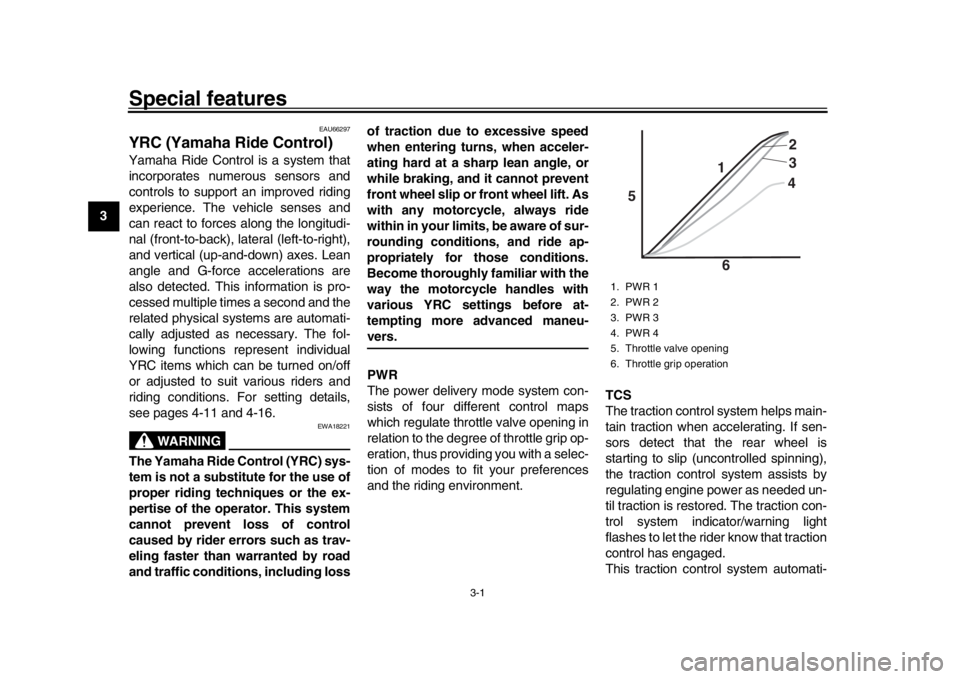
3-1
1
23
4
5
6
7
8
9
10
11
12
Special features
EAU66297
YRC (Yamaha Ride Control)Yamaha Ride Control is a system that
incorporates numerous sensors and
controls to support an improved riding
experience. The vehicle senses and
can react to forces along the longitudi-
nal (front-to-back), lateral (left-to-right),
and vertical (up-and-down) axes. Lean
angle and G-force accelerations are
also detected. This information is pro-
cessed multiple times a second and the
related physical systems are automati-
cally adjusted as necessary. The fol-
lowing functions represent individual
YRC items which can be turned on/off
or adjusted to suit various riders and
riding conditions. For setting details,
see pages 4-11 and 4-16.
WARNING
EWA18221
The Yamaha Ride Control (YRC) sys-
tem is not a substitute for the use of
proper riding techniques or the ex-
pertise of the operator. This system
cannot prevent loss of control
caused by rider errors such as trav-
eling faster than warranted by road
and traffic condition s, including lossof traction due to excessive speed
when entering turns, when acceler-
ating hard at a sharp lean angle, or
while braking, and it cannot prevent
front wheel slip or front wheel lift. As
with any motorcycle, always ride
within in your limits, be aware of sur-
rounding conditions, and ride ap-
propriately for those conditions.
Become thoroughly familiar with the
way the motorcycle handles with
various YRC settings before at-
tempting more advanced maneu-
vers.
PWR
The power delivery mode system con-
sists of four different control maps
which regulate throttle valve opening in
relation to the degree of throttle grip op-
eration, thus providing you with a selec-
tion of modes to fit your preferences
and the riding environment.
TCS
The traction control system helps main-
tain traction when accelerating. If sen-
sors detect that the rear wheel is
starting to slip (uncontrolled spinning),
the traction control system assists by
regulating engine power as needed un-
til traction is restored. The traction con-
trol system indicator/warning light
flashes to let the rider know that traction
control has engaged.
This traction control system automati-
1. PWR 1
2. PWR 2
3. PWR 3
4. PWR 4
5. Throttle valve opening
6. Throttle grip operation
5
64
3 2
1
BX4-9-E1_1.book 1 ページ 2018年4月27日 金曜日 午後4時3分
Page 20 of 130
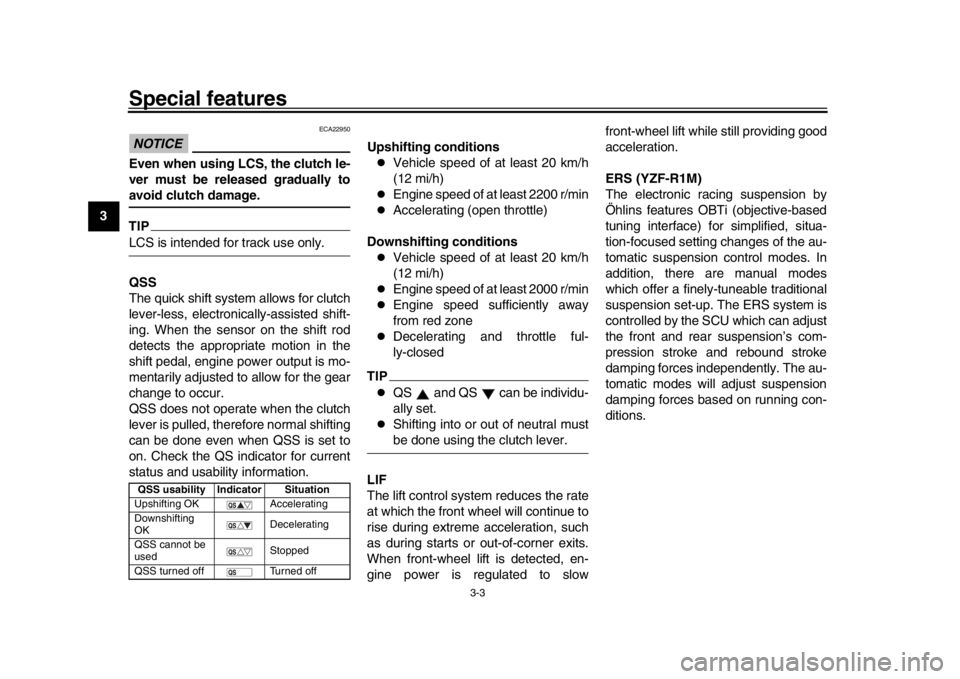
Special features
3-3
1
23
4
5
6
7
8
9
10
11
12
NOTICE
ECA22950
Even when using LCS, the clutch le-
ver must be released gradually toavoid clutch damage.TIPLCS is intended for track use only.
QSS
The quick shift system allows for clutch
lever-less, electronically-assisted shift-
ing. When the sensor on the shift rod
detects the appropriate motion in the
shift pedal, engine power output is mo-
mentarily adjusted to allow for the gear
change to occur.
QSS does not operate when the clutch
lever is pulled, therefore normal shifting
can be done even when QSS is set to
on. Check the QS indicator for current
status and usability information. Upshifting conditions
Vehicle speed of at least 20 km/h
(12 mi/h)
Engine speed of at least 2200 r/min
Accelerating (open throttle)
Downshifting conditions
Vehicle speed of at least 20 km/h
(12 mi/h)
Engine speed of at least 2000 r/min
Engine speed sufficiently away
from red zone
Decelerating and throttle ful-
ly-closed
TIP
QS and QS can be individu-
ally set.
Shifting into or out of neutral mustbe done using the clutch lever.
LIF
The lift control system reduces the rate
at which the front wheel will continue to
rise during extreme acceleration, such
as during starts or out-of-corner exits.
When front-wheel lift is detected, en-
gine power is regulated to slow front-wheel lift while still providing good
acceleration.
ERS (YZF-R1M)
The electronic racing suspension by
Öhlins features OBTi (objective-based
tuning interface) for simplified, situa-
tion-focused setting changes of the au-
tomatic suspension control modes. In
addition, there are manual modes
which offer a finely-tuneable traditional
suspension set-up. The ERS system is
controlled by the SCU which can adjust
the front and rear suspension’s com-
pression stroke and rebound stroke
damping forces independently. The au-
tomatic modes will adjust suspension
damping forces based on running con-
ditions.
QSS usability Indicator Situation
Upshifting OK Accelerating
Downshifting
OK Decelerating
QSS cannot be
used Stopped
QSS turned off Turned off
BX4-9-E1_1.book 3 ページ 2018年4月27日 金曜日 午後4時3分
Page 46 of 130
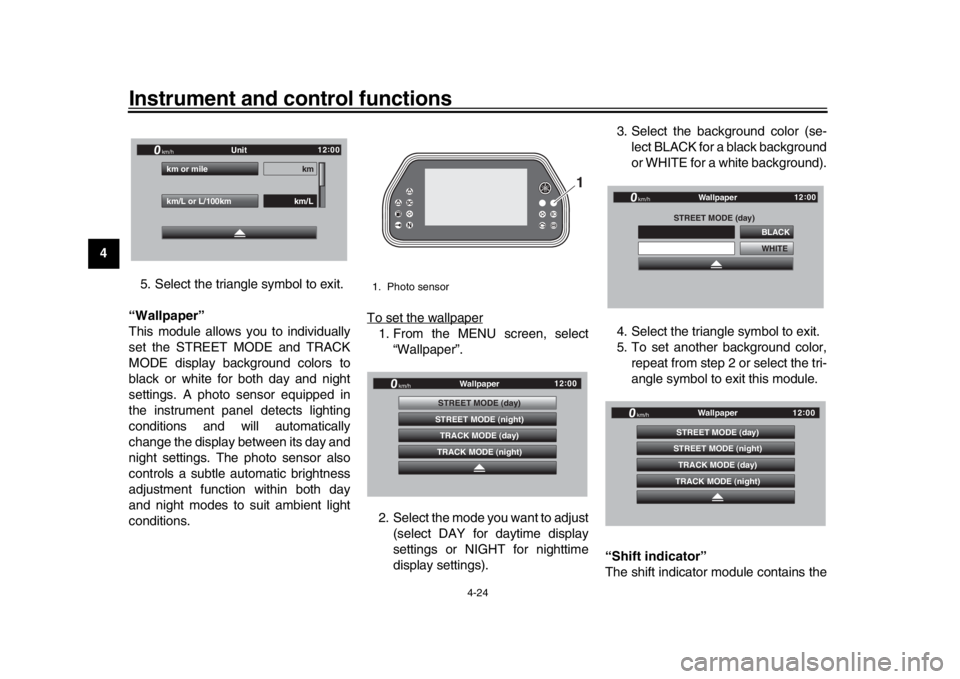
Instrument and control functions
4-24
1
2
34
5
6
7
8
9
10
11
12 5. Select the triangle symbol to exit.
“Wallpaper”
This module allows you to individually
set the STREET MODE and TRACK
MODE display background colors to
black or white for both day and night
settings. A photo sensor equipped in
the instrument panel detects lighting
conditions and will automatically
change the display between its day and
night settings. The photo sensor also
controls a subtle automatic brightness
adjustment function within both day
and night modes to suit ambient light
conditions. To set the wallpaper
1. From the MENU screen, select
“Wallpaper”.
2. Select the mode you want to adjust (select DAY for daytime display
settings or NIGHT for nighttime
display settings). 3. Select the background color (se-
lect BLACK for a black background
or WHITE for a white background).
4. Select the triangle symbol to exit.
5. To set another background color, repeat from step 2 or select the tri-
angle symbol to exit this module.
“Shift indicator”
The shift indicator module contains the
km/L or L/100km km/Lkm or mile km
Unit
km/h
GPGPS
12:
00
1. Photo sensor
1
GP GPS
TRACK MODE (day)
STREET MODE (night)
TRACK MODE (night) Wallpaper
STREET MODE (day)
km/h
12 :
00
WHITEBLACK
Wallpaper
STREET MODE (day)
km/h
GPGPS
12 :
00
GP GPS
TRACK MODE (day)
STREET MODE (night)
TRACK MODE (night) Wallpaper
STREET MODE (day)
km/h
12 :
00
BX4-9-E1_1.book 24 ページ 2018年4月27日 金曜日 午後4時3分
Page 53 of 130

Instrument and control functions
4-31
1
2
345
6
7
8
9
10
11
12
EAU12822
Clutch leverThe clutch lever is located on the left
side of the handlebar. To disengage
the clutch, pull the lever toward the
handlebar grip. To engage the clutch,
release the lever. The lever should be
pulled rapidly and released slowly for
smooth clutch operation.
The clutch lever is equipped with a
clutch switch, which is part of the igni-
tion circuit cut-off system. (See
page 4-49.)
EAU83690
Shift pedalThe shift pedal is located on the left
side of the motorcycle. To shift the
transmission to a higher gear, move the
shift pedal up. To shift to the transmis-
sion to a lower gear, move the the shift
pedal down. (See page 6-2.)
The shift rod is equipped with a shift
sensor, which is part of the quick shift
system. The shift sensor reads up and
down movement, as well as the
strength of the input force when the
shift pedal is moved.TIPTo prevent unintended shifts, QSS is programmed to ignore unclear input
signals. Therefore, be sure to shift us-
ing quick and sufficiently forceful in-
puts.
1. Clutch lever
1
1. Shift pedal
2. Shift sensor
1
2
BX4-9-E1_1.book 31 ページ 2018年4月27日 金曜日 午後4時3分
Page 55 of 130
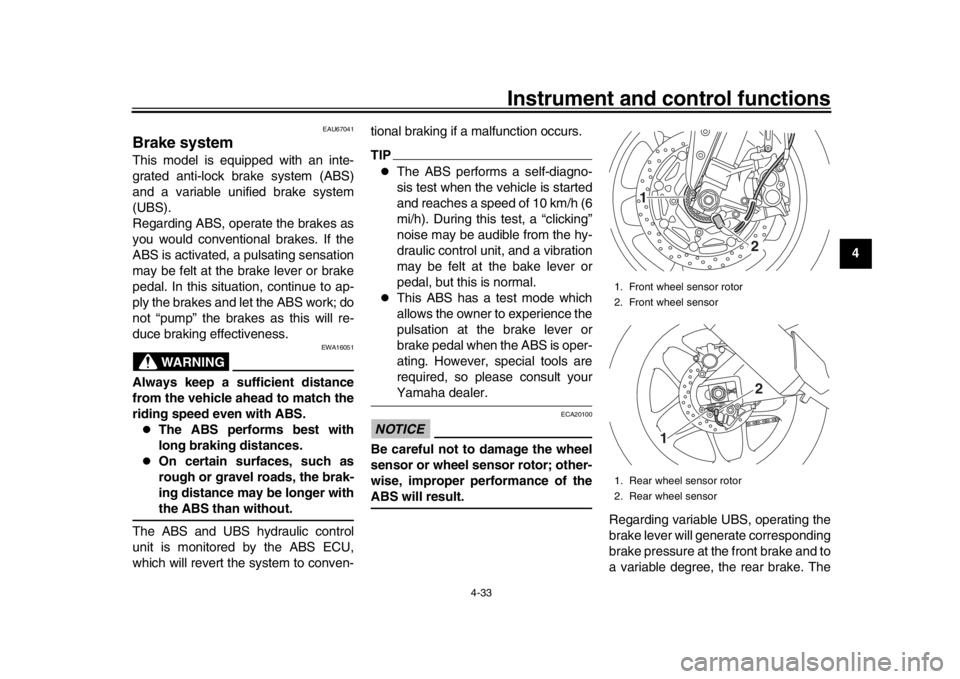
Instrument and control functions
4-33
1
2
345
6
7
8
9
10
11
12
EAU67041
Brake systemThis model is equipped with an inte-
grated anti-lock brake system (ABS)
and a variable unified brake system
(UBS).
Regarding ABS, operate the brakes as
you would conventional brakes. If the
ABS is activated, a pulsating sensation
may be felt at the brake lever or brake
pedal. In this situation, continue to ap-
ply the brakes and let the ABS work; do
not “pump” the brakes as this will re-
duce braking effectiveness.
WARNING
EWA16051
Always keep a sufficient distance
from the vehicle ahead to match the
riding speed even with ABS.
The ABS performs best with
long braking distances.
On certain surfaces, such as
rough or gravel roads, the brak-
ing distance may be longer withthe ABS than without.
The ABS and UBS hydraulic control
unit is monitored by the ABS ECU,
which will revert the system to conven- tional braking if a malfunction occurs.
TIP
The ABS performs a self-diagno-
sis test when the vehicle is started
and reaches a speed of 10 km/h (6
mi/h). During this test, a “clicking”
noise may be audible from the hy-
draulic control unit, and a vibration
may be felt at the bake lever or
pedal, but this is normal.
This ABS has a test mode which
allows the owner to experience the
pulsation at the brake lever or
brake pedal when the ABS is oper-
ating. However, special tools are
required, so please consult yourYamaha dealer.
NOTICE
ECA20100
Be careful not to damage the wheel
sensor or wheel sensor rotor; other-
wise, improper performance of theABS will result.
Regarding variable UBS, operating the
brake lever will generate corresponding
brake pressure at the front brake and to
a variable degree, the rear brake. The
1. Front wheel sensor rotor
2. Front wheel sensor
1. Rear wheel sensor rotor
2. Rear wheel sensor
1
22
1
BX4-9-E1_1.book 33 ページ 2018年4月27日 金曜日 午後4時3分
Page 126 of 130
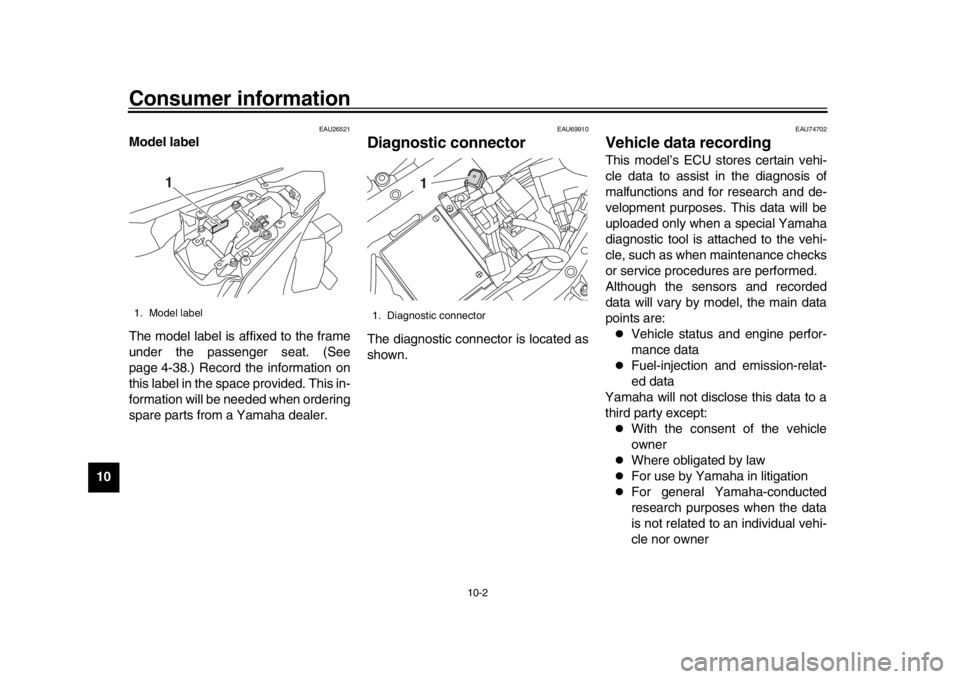
Consumer information
10-2
1
2
3
4
5
6
7
8
910
11
12
EAU26521
Model label
The model label is affixed to the frame
under the passenger seat. (See
page 4-38.) Record the information on
this label in the space provided. This in-
formation will be needed when ordering
spare parts from a Yamaha dealer.
EAU69910
Diagnostic connectorThe diagnostic connector is located as
shown.
EAU74702
Vehicle data recordingThis model’s ECU stores certain vehi-
cle data to assist in the diagnosis of
malfunctions and for research and de-
velopment purposes. This data will be
uploaded only when a special Yamaha
diagnostic tool is attached to the vehi-
cle, such as when maintenance checks
or service procedures are performed.
Although the sensors and recorded
data will vary by model, the main data
points are:
Vehicle status and engine perfor-
mance data
Fuel-injection and emission-relat-
ed data
Yamaha will not disclose this data to a
third party except:
With the consent of the vehicle
owner
Where obligated by law
For use by Yamaha in litigation
For general Yamaha-conducted
research purposes when the data
is not related to an individual vehi-
cle nor owner
1. Model label
1
1. Diagnostic connector
1
BX4-9-E1_1.book 2 ページ 2018年4月27日 金曜日 午後4時3分